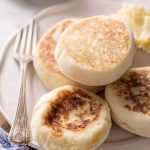Description
These Homemade English Muffins are absolutely irresistible. They boast a wonderfully fluffy interior and that classic craggy surface perfect for toasting and slathering with butter or jam!
Ingredients
- 2 ¾ cups (340 grams) all-purpose flour
- 2 ¼ teaspoons (7 grams) instant or rapid rise yeast
- 1 teaspoon (5 grams) salt
- 2 tablespoons (25 grams) sugar
- ¾ cup (180 ml) whole milk
- ½ cup (120 ml) water
- 3 tablespoons (45 grams) unsalted butter, melted
- 1 large egg (50 grams), at room temperature
- A bit of cornmeal or semolina, for dusting
Instructions
- Combine the milk, water, and sugar in a small bowl or measuring cup. Stir them together. Warm this mixture slightly in the microwave until it reaches about 110°F (43°C). Stir in the yeast. Let the mixture sit undisturbed for 5 to 7 minutes until you see a foamy layer on top.
- While the yeast mixture is activating, put the flour and salt into the bowl of your stand mixer. Whisk them together briefly. Attach the paddle attachment to the mixer.
- Mix the room temperature egg and the melted butter into the milk mixture you prepared earlier. With the mixer running on a low speed, slowly pour the liquid mixture into the flour mixture. Once everything is combined, increase the mixer speed to medium-high. Continue mixing for about 7 minutes until the dough looks smooth and feels elastic.
- Lightly oil a large bowl. Transfer the dough into the bowl. Cover the bowl tightly with plastic wrap. Find a warm spot and let the dough rise until it has doubled in size, which usually takes about an hour. Alternatively, you can place the dough in the refrigerator to rise slowly overnight. If you do this, let it warm up at room temperature for about an hour before you are ready to use it.
- Dust a clean counter surface with flour. Gently transfer the dough onto the floured surface. Carefully spread and pat the dough down until it is just under an inch thick. Get two baking sheets ready by lining them with parchment paper. Sprinkle cornmeal or semolina generously over the parchment paper on both sheets.
- Use a 3 inch round cutter to cut out the individual muffins from the dough. Carefully lift each cut round and place it gently onto the prepared baking sheets using a spatula or your hands. Gather the dough scraps together, gently form them into a ball, and pat them down again. Continue cutting rounds from the re-rolled scraps until all the dough is used. Loosely cover the cut muffins on the baking sheets with plastic wrap. Place them in a warm spot to rise again for approximately 30 minutes.
- Place a large skillet over very low heat. Once you can feel warmth radiating from the pan when you hold your hand a few inches above it, sprinkle the surface with cornmeal or semolina. Carefully place 3 to 4 muffins onto the hot pan, making sure not to overcrowd it. Cover the skillet and cook for 5 to 6 minutes. Then, carefully flip each muffin over and cook the second side for another 5 to 6 minutes until they are golden brown and cooked through.
- Once a batch is cooked, remove any leftover cornmeal from the pan. Add a fresh sprinkle of cornmeal or semolina before cooking the next batch of muffins. Cook the remaining muffins in batches until they are all finished. Serve them warm. If this is your first time making them, it is a good idea to cook one test muffin first to get a feel for the cooking time and heat.
Notes
Proofing Time: While you can let the dough rise for just one hour, it will develop more flavor if you give it a longer proofing time, around 4 to 8 hours is ideal.
Equipment: Using a stand mixer is highly recommended for this recipe because the dough is quite sticky and can be challenging to mix and knead by hand.
Ingredient Substitution: If you use bread flour instead of all-purpose flour, your muffins will have a slightly chewier texture.
Rising Conditions: To help the dough rise faster, place it in a warm environment. However, avoid placing it in a hot spot or direct sunlight, as this can negatively affect the rise.
Shaping: If you do not have a round cutter, you can shape the dough into individual rounds by hand.
Troubleshooting: If your muffins feel undercooked and overly soft in the middle, finish cooking them in a 350°F (175°C) oven for about 3 minutes. This should help them firm up perfectly.
Preventing Sticking: If you notice the muffins sticking to the pan while cooking, add a very small amount of butter to the skillet.
Pan Type: A cast-iron skillet or a griddle works best for cooking English muffins.
Cooking in Batches: You will need to cook the muffins in batches. Remember to brush away any excess semolina or cornmeal from the pan between batches to prevent it from burning.
Serving Tip: Use a serrated knife to easily slice open the muffins when you are ready to serve them.
Best Enjoyed Toasted: English muffins are truly at their best when served toasted.
Storage: Cooked English muffins store well in an airtight container at room temperature for 3 to 5 days. For longer storage, they can be frozen for up to 3 months.
Nutrition
- Serving Size: 1 muffin
- Calories: 135 kcal
- Sugar: 2 g
- Sodium: 200 mg
- Fat: 3 g
- Carbohydrates: 23 g
- Fiber: 1 g
- Protein: 4 g
- Cholesterol: 9 mg
